The constellations in tonight’s sky host many familiar star patterns. For northern observers, early winter is the best time of the year to see Perseus, Auriga (the Charioteer), Triangulum (the Triangle), Taurus (the Bull), and Aries (the Ram). The dominant patterns of these constellations appear high overhead in the evening.
Observers in the southern hemisphere can catch Eridanus (the River), Fornax (the Furnace), Phoenix, and Horologium (the Pendulum Clock) high in the evening sky. These constellations are not particularly conspicuous but can be found using the bright stars in the vicinity.
The night sky tonight looks different depending on the location. The constellation maps below show the sky at around 10 pm in the mid-northern, equatorial, and mid-southern latitudes.
Northern hemisphere
Perseus and Auriga (the Charioteer) dominate the evening sky for observers in the northern hemisphere. Their conspicuous asterisms – the Segment of Perseus and Auriga’s hexagon – appear close to the Milky Way’s band.
These asterisms can be used to find several bright deep sky objects that lie in this region of the sky. These include the Little Dumbbell Nebula (M76), the open cluster M34 and the Double Cluster (NGC 869 and NGC 884) in Perseus, and the open clusters M36, M37 and M38 in Auriga.
The supergiant Mirfak, the brightest star in Perseus, is part of the Segment of Perseus and the central star in the Alpha Persei Cluster (Collinder 39).
Auriga hosts Capella, the sixth brightest star in the sky. Capella sits at the top of Auriga’s hexagon. Elnath, the star opposite Capella in the hexagon, marks the northern horn of the Bull and is part of the constellation Taurus. It is the constellation’s second brightest star.
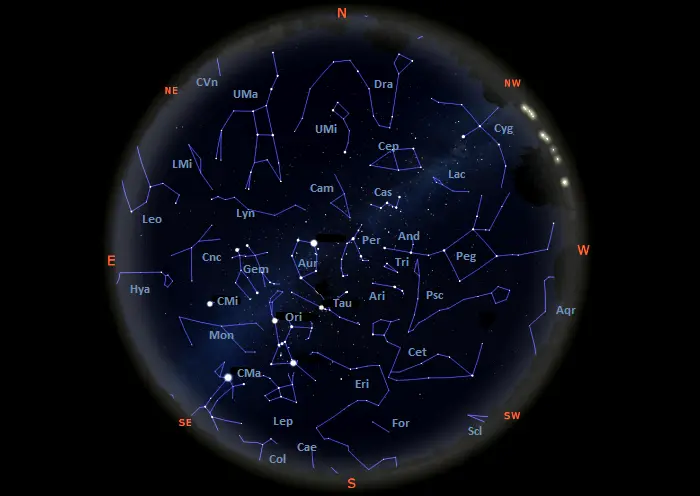
Tonight’s sky as seen from mid-northern latitudes, image: Stellarium
The orange giant Aldebaran, the brightest star in Taurus, is the 14th brightest star in the sky. It appears as part of the V-shaped Hyades open cluster, which marks the Bull’s head. However, the giant is really much closer to us and is not a member of the Hyades. It marks one of the Bull’s eyes. Ain, one of the brightest Hyades members, marks the other.
Aldebaran and the Hyades can be found by extending an imaginary line from the stars of Orion’s Belt to the northwest. Extending the line further leads to the bright Pleiades, one of the brightest and most recognizable open clusters in the sky.
The small but distinctive constellation figures of Triangulum (the Triangle) and Aries (the Ram) appear just south of Andromeda. The brightest stars of Triangulum, the home of the Triangulum Galaxy (M33), form an elongated triangle, while the luminaries of Aries form a flat triangle near Triangulum.
Eastern sky
The brightest constellation in the eastern sky around 10 pm is Gemini. The heads of the celestial Twins are marked by the bright stars Pollux and Castor, the 17th and 23rd brightest stars in the sky.
Pollux is part of the Winter Circle, a bright, large asterism that extends toward the southeast. The asterism is formed by Pollux with Capella in Auriga, Aldebaran in Taurus, Rigel in Orion, Sirius in Canis Major, and Procyon in Canis Minor. Sirius and Procyon form a smaller seasonal asterism, the Winter Triangle, with Betelgeuse in Orion.
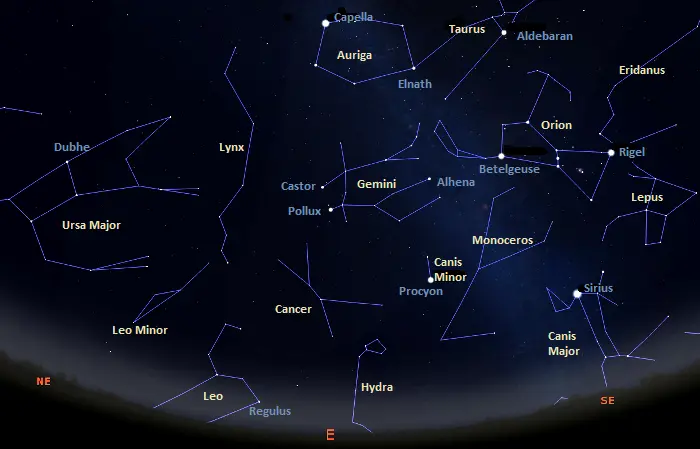
Eastern sky in the northern hemisphere, image: Stellarium
Leo rises in the east around 10 pm. Regulus, its brightest star, appears at the base of a backward question mark known as the Sickle of Leo. The Sickle represents the Lion’s head and mane.
The zodiac constellation Cancer is very faint. Its brightest star, the orange giant Tarf, shines at magnitude 3.5. However, the constellation can be found using the bright Beehive Cluster (M44), which is visible to the unaided eye on a clear night. M44 lies in the region between Regulus and Pollux.
Hydra, the largest constellation in the sky, rises in the east in the evening. The head of Hydra is visible above the eastern horizon on a clear night.
Ursa Major (the Great Bear) dominates the northeastern sky, while Orion (the Hunter) is the brightest constellation in the southeast. Sirius, the luminary of Canis Major (the Great Dog) appears directly above the southeastern horizon in the evening. It lies on the imaginary line extended from the stars of Orion’s Belt to the southeast.
Northern sky
The constellations appearing directly north around 10 pm are Draco (the Dragon) and Ursa Minor (the Little Bear). The brighter Cygnus (the Swan) and Ursa Major (the Great Bear) lie to the northwest and the northeast.
The Northern Cross, the dominant pattern of the celestial Swan, can be used to find the head of Draco. A line extended through the beam of the Cross leads to Eltanin and Rastaban, the stars that mark the Dragon’s eyes.
The head of Draco appears low above the northern horizon. It is outlined by an asterism sometimes known as the Lozenge. The rest of the Dragon’s body curves around the bowl of the Little Dipper in the direction of the Great Bear. The Dragon’s tail is found between the Big and Little Dippers.
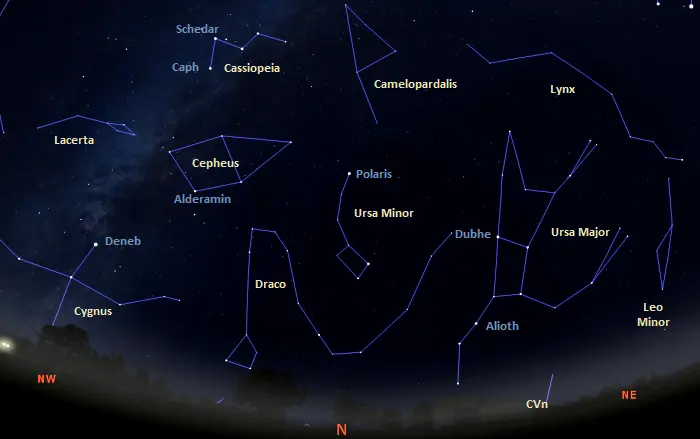
Northern sky in the northern hemisphere, image: Stellarium
The Big Dipper can be used to find Polaris, the North Star. Polaris marks the tip of the Little Bear’s tail and the end of the Little Dipper’s handle. It is the brightest star appearing along the imaginary line extended from Merak through Dubhe. Merak and Dubhe, the outer stars of the Big Dipper’s bowl, are called the Pointers because they point in the direction of Polaris, the star that marks true north.
The constellation figure of Cepheus (the King) does not stand out in the sky, but it can be found using the brighter stars of Cassiopeia (the Queen). A line drawn from Schedar through Caph leads to Alderamin, the brightest star in Cepheus. Alderamin appears at the base of the house asterism that makes Cepheus easily recognizable on a clear, dark night.
The faint Camelopardalis (the Giraffe) appears high in the northern sky but is difficult to see from urban areas. The supergiant Beta Camelopardalis, the constellation’s brightest star, has an apparent magnitude of 4.02.
Western sky
Two bright, recognizable constellations – Pegasus (the Winged Horse) and Andromeda (the Princess) – appear directly above the western horizon around 10 pm.
Pegasus, the seventh largest constellation in the sky, contains one of the most distinctive asterisms of the northern autumn sky, the Great Square of Pegasus. The pattern is formed by the Pegasus stars Scheat, Markab and Algenib with Alpheratz in the neighbouring constellation Andromeda. It represents the main body of Pegasus, the winged horse in Greek mythology.
The asterism can be used to find several bright deep sky objects in this region of the sky. These include the bright globular cluster Messier 15 and the unbarred spiral galaxy NGC 7331. The famous compact group known as Stephan’s Quintet appears near the NGC 7331 Group.
Enif, the brightest star in Pegasus, is the brightest star appearing low above the western horizon in the evening.
Alpheratz at the northeastern vertex of the Great Square is the first in a chain of three bright stars that make the Andromeda constellation easy to identify.
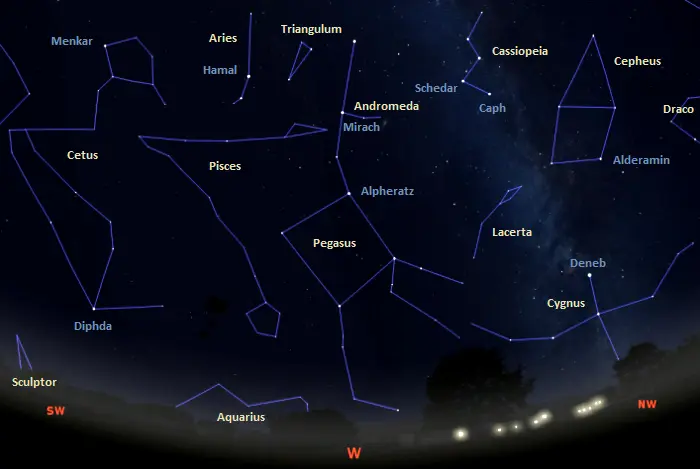
Western sky in the northern hemisphere, image: Stellarium
Mirach, the central star in the chain, is about as bright as Alpheratz and well-known to stargazers because it is used to find the Andromeda Galaxy (M31), the nearest large galaxy to the Milky Way, and the Triangulum Galaxy (M33). These galaxies are members of the Local Group, the home of the Milky Way. They are the most distant objects visible to the unaided eye, but can only be spotted in exceptionally good conditions. Almach, the third star in the chain, lies in the direction of the Perseus constellation.
The zodiac constellation Pisces (the Fishes), the 14th largest constellation in the sky, appears south of the Square of Pegasus. Pisces is relatively inconspicuous but can be found using the stars of Andromeda and Pegasus. The head of the western fish is represented by an asterism known as the Circlet of Pisces. It lies below the imaginary line connecting Algenib and Markab in the Great Square. The head of the eastern fish is harder to make out. It appears near Mirach in Andromeda.
Southern sky
Eridanus, the celestial River, occupies much of the southern sky in the evening. Achernar (Alpha Eridani), the constellation’s brightest star, stays below the horizon for northern observers, but most of the constellation is visible at this time of the year.
Eridanus is the sixth largest constellation in the sky. It extends farther from north to south than any other constellation. Cursa (Beta Eridani), the constellation’s second brightest star, marks its northern end. It appears near Rigel at Orion’s foot. The famous Witch Head Nebula (IC 2118), a reflection nebula illuminated by Rigel, appears in the region between Rigel and Cursa.
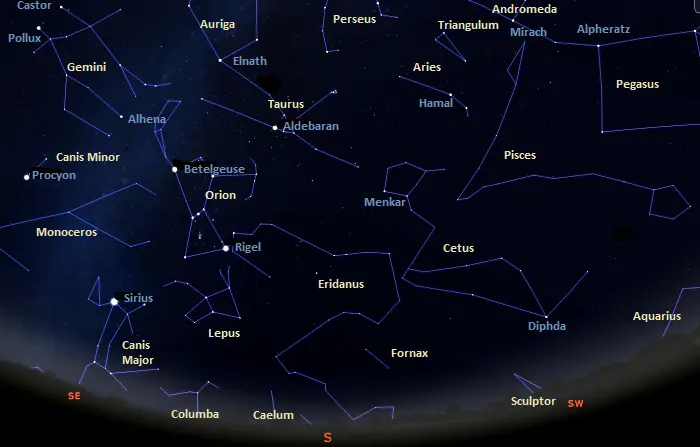
Southern sky from the northern hemisphere, image: Stellarium
Fornax (the Furnace) may be spotted in the River’s bend on a very clear, dark night. It is one of the faintest constellations in the sky. Its brightest star, Dalim (Alpha Furnacis), shines at magnitude 3.85.
Orion and Canis Major dominate the southeastern sky. The stars of Orion’s Belt can be used to identify Sirius, the brightest star in the sky, and Aldebaran, the luminary of Taurus. The less conspicuous Lepus (the Hare) is visible below Orion’s feet.
Cetus (the Sea Monster), the fourth largest of the 88 constellations, appears above the southwestern horizon. The constellation’s brightest stars, Diphda (Beta Ceti) and Menkar (Alpha Ceti), appear at opposite ends of the constellation. Diphda marks the Sea Monster’s tail and Menkar its nostril.
Equatorial latitudes
Observers in equatorial latitudes see many of the same constellations as those in the mid-northern locations, but these constellations do not appear in the same place. Additionally, observers near the equator can see many constellations in the southern sky that are invisible to northern observers.
The constellations high overhead around 10 pm are Taurus (the Bull), Orion (the Hunter), Lepus (the Hare), Cetus (the Sea Monster), and Eridanus (the River). These constellations appear in the southern sky for observers in the mid-northern latitudes.
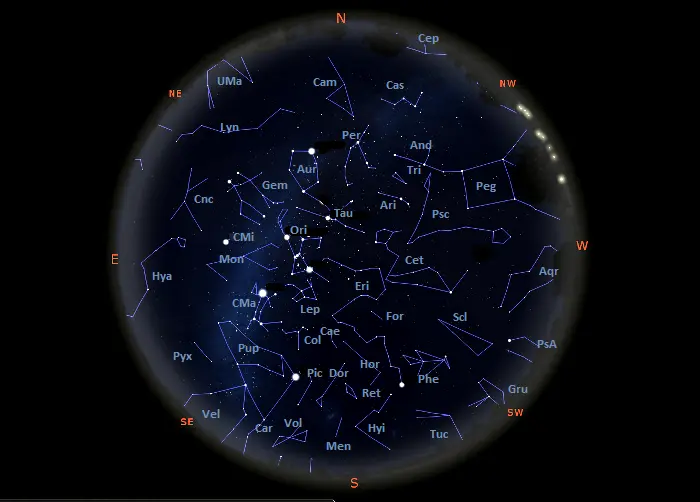
Tonight’s sky as seen from equatorial latitudes, image: Stellarium
Cetus is one of the largest constellations in the sky, but it is not very conspicuous. Its brightest stars, the giants Diphda (Beta Ceti) and Menkar (Alpha Ceti), shine at magnitudes 2.02 and 2.53.
Diphda appears in the tail of Cetus, in the same area as the bright Sculptor Galaxy (NGC 253), and Menkar lies in the head of Cetus, not far from the Squid Galaxy (M77). The famous variable star Mira appears in the Sea Monster’s neck.
Eridanus (the River) curves from Cursa (Beta Eridani) near the zenith to Achernar (Alpha Eridani) in the far southern sky. Achernar is the ninth brightest star in the sky. It marks the River’s southern end.
Orion is one of the most recognizable constellations in the sky. Its seven brightest stars are all brighter than magnitude 2.50. They form a crooked hourglass pattern that represents the celestial Hunter.
Most of these stars are hot blue giants and supergiants, destined to go out as spectacular supernovae. The blue supergiant Rigel (Beta Orionis) at Orion’s foot and the red supergiant Betelgeuse (Alpha Orionis) at the Hunter’s shoulder are the seventh and tenth brightest stars in the sky.
Lepus appears at Orion’s foot. It represents a hare chased by Orion and his two dogs, Canis Major (the Great Dog) and Canis Minor (the Little Dog). The hare’s ears lie below Rigel and its tail below Saiph.
Taurus, one of the oldest constellations in the sky, appears high overhead in the evening. It is easily recognizable because it hosts two exceptionally bright, large open clusters: the Pleiades and the Hyades.
The Pleiades cluster marks the Bull’s shoulder and the Hyades its V-shaped head. Aldebaran, the 14th brightest star in the sky, marks the Bull’s eye and appears as a member of the Hyades, but is in fact much closer to us. It lies 67 light-years away, while the cluster is about 153 light-years away.
The Pleiades and the Hyades form the Golden Gate of the Ecliptic, an asterism that helps observers find the ecliptic, the apparent path of the Sun across the sky. The ecliptic passes through the region between the two clusters.
Northern sky
The brightest constellations above the northern horizon at this time of the year are Perseus, Cassiopeia (the Queen), and Auriga (the Charioteer). They all contain bright star patterns that make them easy to identify.
Perseus appears high above the northern horizon. Its brightest star, Mirfak (Alpha Persei), is part of the Segment of Perseus, an asterism formed by a curving line of stars that stretches from Cassiopeia in the direction of Auriga. Mirfak is the central star in the Alpha Persei Cluster, a bright, large open cluster visible without binoculars.
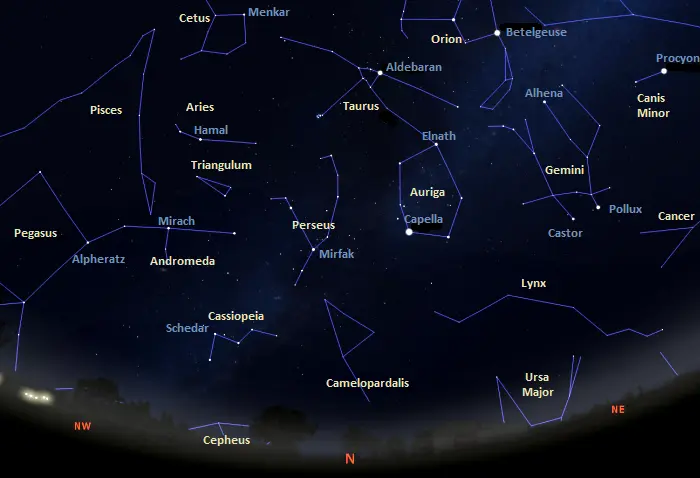
Northern sky from equatorial latitudes, image: Stellarium
Cassiopeia appears lower in the sky, toward the northwest. Its five brightest stars – Caph, Schedar, Tiansi, Ruchbah, and Segin – form a W in the sky. The W sometimes appears as an M, depending on the time of the year or night and the observer’s location.
The asterism can be used to find several bright deep sky objects that appear in this region of the sky, including the Double Cluster in Perseus, the open clusters Messier 103 and Messier 52, and the Bubble Nebula (NGC 7635) in Cassiopeia.
Auriga appears between Perseus and Gemini (the Twins). Its distinctive feature is a hexagon pattern formed by its brightest stars, including Capella, the sixth brightest star in the sky.
The second brightest star in the hexagon is Elnath (Beta Tauri), the star that marks the northern horn of the Bull and belongs to the neighbouring Taurus constellation. Auriga’s hexagon can be used to find the open clusters M36, M37, and M38.
Camelopardalis (the Giraffe) appears between Perseus and the horizon around 10 pm. It is one of the faintest constellations in the sky. Beta Camelopardalis, the constellation’s brightest star, has an apparent magnitude of 4.02.
Eastern sky
The constellations rising in the east include Hydra (the Water Snake), Cancer (the Crab), Canis Minor (the Little Dog), and Monoceros (the Unicorn).
Hydra is the largest constellation in the sky, stretching across 1302.844 square degrees of the mostly southern sky. It is one of the 15 equatorial constellations, visible from anywhere on Earth for at least part of the year.
Despite its size, Hydra is not particularly prominent. The orange giant Alphard, its brightest star, shines at magnitude 2.00, and the second brightest star is almost a full magnitude fainter. The asterism representing the head of Hydra can be spotted below the bright Procyon in the evening.
The neighbouring zodiac constellation Cancer is even fainter. Its brightest star, the orange giant Tarf (Beta Cancri) shines at magnitude 3.5.
The constellation’s most recognizable feature is Praesepe (Messier 44), one of the brightest and largest open clusters in the sky. Also known as the Beehive Cluster, M44 has an apparent magnitude of 3.7 and covers an area of 95 arcminutes, roughly three times the size of the full Moon. The cluster is easily visible to the unaided eye, appearing as a nebulous patch between Regulus in Leo and Pollux in Gemini.
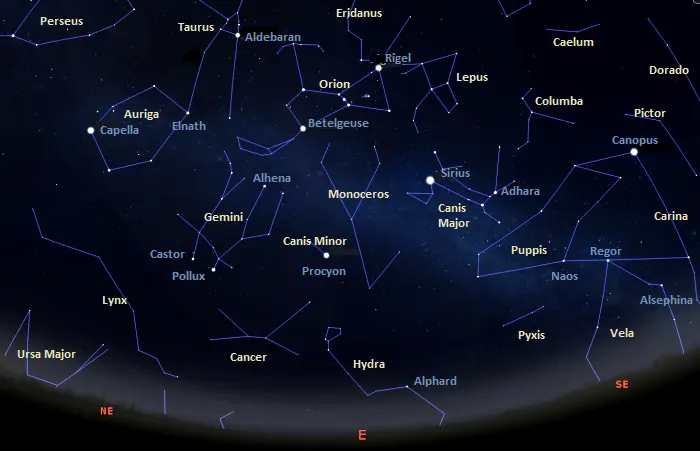
Eastern sky from equatorial latitudes, image: Stellarium
Canis Minor represents the smaller or the two dogs following Orion, the Hunter. It is home to Procyon, the eighth brightest star in the sky. Procyon is one of our nearest neighbours, located only 11.46 light-years from the Sun.
Monoceros (the Unicorn) appears between Orion and Hydra. It is another faint constellation that can only be made out in very good conditions. Its brightest star, the yellow giant Alpha Monocerotis, has an apparent magnitude of 3.94.
Monoceros hosts several well-known deep sky objects: the Rosette Nebula (Caldwell 49), the Cone Nebula with the Christmas Tree Cluster (NGC 2264), the open cluster Messier 50, and Hubble’s Variable Nebula (NGC 2261).
M50 appears between Sirius and Procyon, the Rosette and Cone nebulae lie in the region between Procyon and Betelgeuse, and Hubble’s Variable Nebula appears near the Cone Nebula, in the direction of the Rosette.
Western sky
The zodiac constellations Aquarius (the Water Bearer) and Pisces (the Fishes) set in the west in the evening. Aquarius has partly set by 10 pm, while Pisces appears higher above the western horizon.
The two zodiac constellations do not really stand out in the sky. Pisces can be found using the bright stars of the neighbouring Pegasus, and Aquarius appears in the area between Pegasus and the bright Fomalhaut in Piscis Austrinus (the Southern Fish).
Fomalhaut is the 18th brightest star in the sky and it marks the mouth of the Southern Fish. Aquarius is typically depicted as a man pouring water from a jar in the direction of the Southern Fish’s mouth.
Fomalhaut is found by extending a line from the western stars of the Great Square of Pegasus across the sky. It is the brightest star in the otherwise faint Piscis Austrinus, which has partly set by 10 pm.
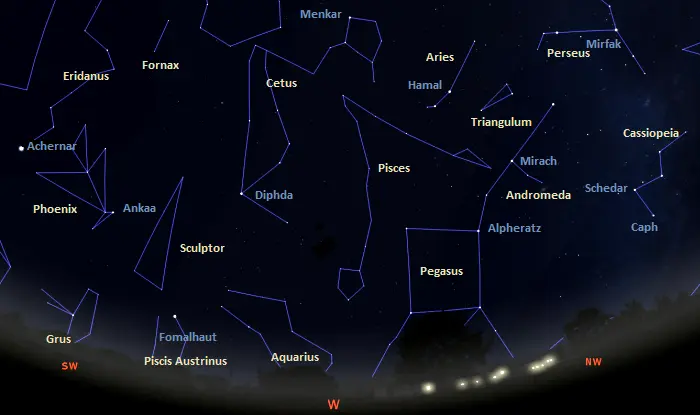
Western sky from equatorial latitudes, image: Stellarium
Pisces is identified using the Circlet of Pisces, an asterism that represents the head of the western fish. The western fish and the eastern fish are connected by two cords that connect at the relatively faint Alrescha (Alpha Piscium). The head of the eastern fish appears near Mirach in Andromeda.
Sculptor, another faint constellation, can be spotted just above Fomalhaut. It hosts the Sculptor Galaxy (NGC 253), one of the brightest and largest galaxies in the sky.
The Water Jar asterism is the most distinctive feature of Aquarius. The Y-shaped pattern is visible below the imaginary line connecting the bottom left star of the Great Square of Pegasus and the supergiant Enif, the brightest star in Pegasus. Enif is visible earlier in the evening just below the Great Square.
Pegasus appears above the western and northwestern horizon. Its distinguishing asterism, the Great Square of Pegasus, is formed by Algenib, Scheat and Markab with Alpheratz in Andromeda. The asterism forms the main body of Pegasus.
Alpheratz, a star that was once part of both Andromeda and Pegasus, marks the navel of the Winged Horse. It now belongs exclusively to Andromeda.
Andromeda is easily recognizable because its three brightest stars – Alpheratz, Mirach, and Almach – form a chain that extends from the Square of Pegasus in the direction of Mirfak, the brightest star in Perseus. Mirach can be used to find the bright Andromeda Galaxy (M31) and the Triangulum Galaxy (M33), the nearest spiral galaxies to our own galaxy, the Milky Way.
The three bright Andromeda stars make it easy to find the smaller constellation figures of Triangulum (the Triangle) and Aries (the Ram). The brightest stars of Triangulum – Alpha (Mothallah), Beta (Alaybasan), and Gamma Trianguli (Apdu) – form an elongated triangle that appears near the line connecting Mirach and Almach. The luminaries of Aries – Hamal, Sheratan, and Mesarthim – form a flat triangle between Triangulum and the head of Cetus (the Sea Monster).
Southern sky
Most constellations appearing in the southern sky in the evening are small and faint. On a clear night, they can be identified using the two first-magnitude stars that appear high above the southern horizon, Canopus (Alpha Carinae) and Achernar (Alpha Eridani).
Pictor (the Easel), Dorado (the Dolphinfish), Reticulum (the Reticule) and Horologium (the Pendulum Clock) occupy the area between the two stars. Volans (the Flying Fish) appears below Canopus, Tucana (the Toucan) is partly visible below Achernar, and Mensa (Table Mountain) and Hydrus (the Lesser Water Snake) appear directly south.
Hydrus and Tucana host the Small Magellanic Cloud (SMC), a dwarf galaxy that appears as a detached piece of the Milky Way on a clear night. The Small Magellanic Cloud is one of our galaxy’s closest neighbours. Its larger sibling, the Large Magellanic Cloud (LMC), lies in the less conspicuous Dorado and Mensa.
The constellation Carina (the Keel) appears above the southern and southeastern horizon. Canopus, its brightest star, is the second brightest star in the sky (after Sirius). Miaplacidus and Avior, the second and third brightest stars in Carina, are bright enough to be included on the list of stars selected for use in celestial navigation.
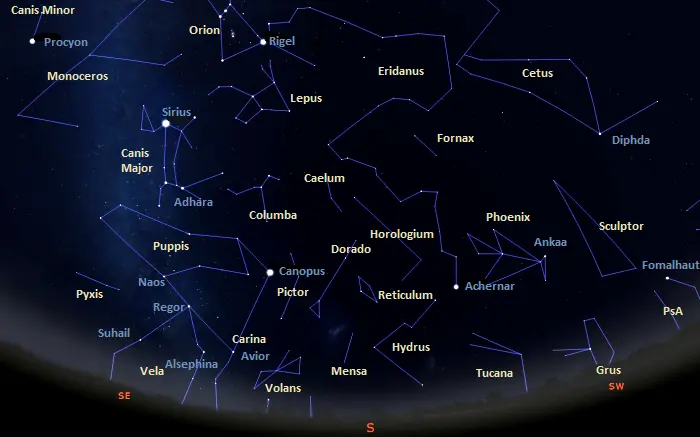
Southern sky from equatorial latitudes, image: Stellarium
Carina once formed Argo Navis (the Ship Argo), the largest constellation in the sky, with the neighbouring Puppis (the Stern) and Vela (the Sails).
Puppis and Vela lie above the southeastern horizon in the evening, below the bright Sirius. The three constellations represented the keel (Carina), stern (Puppis), and sails (Vela) of the mythical ship Argo, on which Jason and the Argonauts sailed on their quest to retrieve the Golden Fleece.
Achernar, the brightest star in Eridanus (the River) and the ninth brightest star in the sky, marks the southern end of the celestial River. The River’s northern end appears in a different part of the sky, about 5 degrees from the celestial equator, near Rigel in Orion.
A triangle of relatively bright Canis Major stars – Adhara, Wezen and Aludra – can be used to find the fainter Columba (the Dove) and Caelum (the Chisel). Columba contains five stars brighter than magnitude 4.0, while the brightest star in Caelum shines at magnitude 4.456.
Southern hemisphere
The constellations appearing high overhead for southern observers around 10 pm include Eridanus (the River), Fornax (the Furnace), Phoenix, and Horologium (the Pendulum Clock).
Eridanus represents the celestial River and stretches the farthest from north to south of all constellations. Its northern end appears near Rigel at the foot of Orion (the Hunter) and its southern end is marked by Achernar, the ninth brightest star in the sky.
Achernar is a hot blue B-type star over 3,000 times more luminous than the Sun. It is the least spherical star known in our galaxy. It spins exceptionally fast, with a projected rotational velocity of 250 km/s. As a result, it has the shape of an oblate spheroid. Its diameter at the equator is 35% greater than its diameter at the poles.
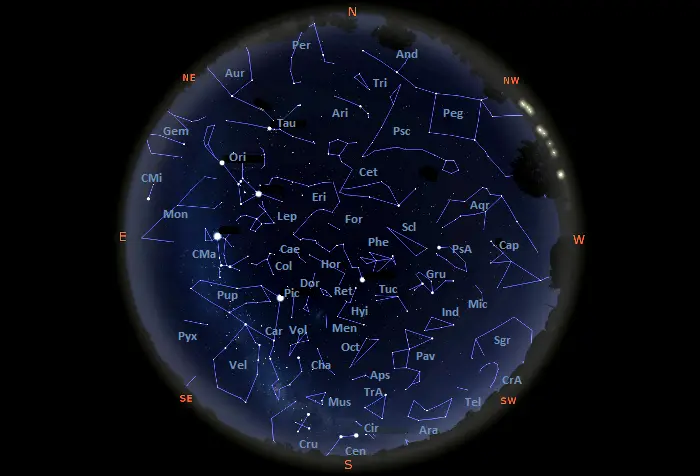
Tonight’s sky as seen from the southern hemisphere, image: Stellarium
Achernar can be used to find the fainter constellations Horologium and Phoenix, which lie to the east and west of the star.
Horologium represents the pendulum clock. It is one of the faintest constellations in the sky. Its brightest star, the orange giant Alpha Horologii, shines at magnitude 3.853 from a distance of about 115 light-years. Only three other stars in the constellation are brighter than magnitude 5.00, making Horologium a difficult target in less-than-ideal conditions.
Phoenix, one of the Southern Birds constellations, is much easier to spot. It contains seven stars brighter than magnitude 4.00. The brightest of these, the orange giant Ankaa (Alpha Phoenicis), has an apparent magnitude of 2.377 and is one of the stars selected for use in the field of celestial navigation. Its name comes from the Arabic word for “phoenix.”
Fornax (the Furnace) is fainter but can be spotted in the bend of the River (Eridanus) on a clear night. The constellation is home to the Fornax Cluster, the second richest cluster of galaxies within 100 million light-years, after the Virgo Cluster.
Northern sky
The constellations appearing above the northern horizon include Aries (the Ram), Triangulum (the Triangle), Cetus (the Sea Monster), and Perseus. Perseus is only partly visible low above the horizon, while the other three constellations appear higher in the sky, directly north.
Triangulum and Aries can be found using the bright stars of Andromeda (the Princess). Andromeda is easy to recognize because its three brightest stars – Alpheratz, Mirach and Almach – form a bright chain between Pegasus and Perseus.
Alpheratz is the brightest star in the Square of Pegasus, a large, prominent asterism that outlines the body of Pegasus. Mirach, the central star, is well-known to astronomy lovers because it can be used to find the Andromeda Galaxy (Messier 31) and the Triangulum Galaxy (Messier 33). The galaxies appear on opposite sides of the star and both are visible to the unaided eye in exceptionally good conditions.
The constellation Triangulum is found above the imaginary line connecting Mirach and Almach, and Aries appears just above Triangulum.
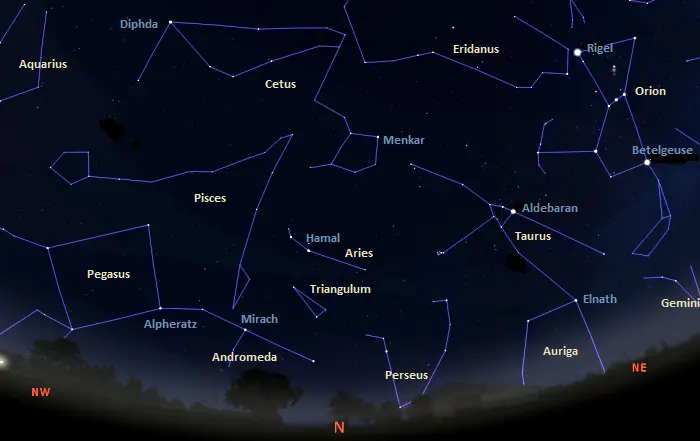
Northern sky in the southern hemisphere, image: Stellarium
Cetus, one of the largest constellations in the sky, represents the Sea Monster from the myth of Andromeda and Perseus. Its head is outlined by a circle of stars that include Menkar, the constellation’s second brightest star.
The head of Cetus can be located using the bright Hyades as a pointer. The V-shaped cluster represents the head of the Bull (Taurus) and points in the direction of Menkar. Diphda, the brightest star in Cetus, lies in the Sea Monster’s tail and can be found using the stars of the Great Square of Pegasus.
The large but faint Pisces (the Fishes) occupies the region between Pegasus and Cetus. The heads of the two fishes can be identified using the brighter stars of Pegasus and Andromeda.
The fishes are connected by two cords that meet at the faint Alrescha. Alpherg, the brightest star in Pisces, is part of the northern cord. It shines at magnitude 3.6 from a distance of 350 light-years. Gamma Piscium, the constellation’s second brightest star, has an apparent magnitude of 3.7 and is part of the Circlet of Pisces, the asterism outlining the head of the western fish.
The bright Taurus (the Bull) and Auriga (the Charioteer) appear in the northeastern sky. Capella, Auriga’s brightest star, is below the horizon around 10 pm, but the constellation’s conspicuous hexagon asterism is partly visible. Elnath, the southernmost star in the asterism, does not belong to Auriga but to Taurus. It marks the northern horn of the celestial Bull.
Tianguan, the star that marks the Bull’s southern horn, is the brightest point of light between Elnath and Betelgeuse in Orion (the Hunter). It can be used to find the bright supernova remnant Messier 1, also known as the Crab Nebula.
The giant Aldebaran, the brightest star in Taurus and the 14th brightest star in the sky, lies in the same line of sight as the Hyades cluster. It is, however, not a member of the Hyades because it lies much closer to us. Aldebaran can be found by extending a line from the three stars of Orion’s Belt to the northwest. Extending the line past Aldebaran leads to the Pleiades, the bright open cluster that marks the celestial Bull’s shoulder.
Eastern sky
Five of the ten brightest stars in the sky – Sirius, Canopus, Rigel, Procyon, and Betelgeuse – are visible in the eastern sky around 10 pm. The two dog constellations – Canis Major (the Great Dog) and Canis Minor (the Little Dog) – host two of these stars. They appear above the eastern horizon in the evening.
Representing the larger of the two dogs following Orion, Canis Major is home to Sirius, the brightest star in the sky and one of our nearest neighbours. Popularly known as the Dog Star, Sirius is one of the hottest stars in the solar neighbourhood. It shines at magnitude -1.46 from a distance of 8.61 light-years, and it is 24.7 times more luminous than the Sun. It has a white dwarf companion, Sirius B, affectionately nicknamed the Pup.
Adhara, the constellation’s second brightest star, is a luminous blue bright giant located 405 light-years away. It forms a triangle with the supergiants Wezen and Aludra that is easily visible south of Sirius even in light-polluted skies.

Eastern sky in the southern hemisphere, image: Stellarium
Canis Minor contains Procyon, another first-magnitude star in the Sun’s neighbourhood. Procyon has an apparent magnitude of 0.34 and lies 11.46 light-years away. It is the eighth brightest star in the sky.
Gomeisa, the second brightest star in Canis Minor, is relatively bright, shining at magnitude 2.89, but the rest of the constellation is hard to spot from urban areas.
Sirius and Procyon form a conspicuous triangle with Betelgeuse at the shoulder of Orion.
Orion stands out in the eastern and northeastern sky. Its seven brightest stars form a prominent hourglass-shaped figure that represents the celestial Hunter. Betelgeuse is the only distinctly red star in the figure. The other six stars are hot blue O- and B-type stars. The supergiants Rigel and Betelgeuse, the brightest stars in Orion, are the seventh and tenth brightest stars in the sky.
The three stars of Orion’s Belt – the blue supergiants Alnitak and Alnilam and bright giant Mintaka – are among the brightest stars in the sky even though they lie more than 1,000 light-years away. They are exceptionally hot and luminous stars, with energy outputs 250,000 (Alnitak), 271,000 (Alnilam), and 190,000 (Mintaka) times that of the Sun.
Rigel can be used to find the fainter Lepus. Representing a hare chased by Orion and his dogs, Lepus appears at Orion’s feet. Its brightest stars form the distinctive figure of the Hare. The Hare’s ears appear right of Rigel and its tail right of Saiph.
Columba (the Dove) is another constellation appearing in the region between Rigel in Orion and Canopus in Carina.
The faint Monoceros (the Unicorn) appears in the area between Orion, Canis Major, and Canis Minor. While the constellation is a popular target for backyard telescopes – it is home to the Rosette Nebula, the Cone Nebula, and the Christmas Tree Cluster – its brightest star shines at magnitude 3.9 and is difficult to see in light-polluted skies.
The three constellations that represent the mythical ship Argo – Carina (the Keel), Puppis (the Stern), and Vela (the Sails) – appear in the southeastern sky. These constellations once formed Argo Navis (the Ship Argo), the largest constellation in the sky. The constellation was divided into the three smaller ones by the French astronomer Nicolas-Louis de Lacaille in the 18th century.
Canopus, the brightest star in Carina, is the second brightest star in the sky. The star system Gamma2 Velorum (Regor), the brightest point of light in Vela, contains the nearest Wolf-Rayet star to the Sun. Naos, the luminary of Puppis, is one of the most luminous stars visible to the unaided eye. It shines with 813,000 solar luminosities.
Western sky
The zodiac constellations Capricornus (the Sea Goat) and Aquarius (the Water Bearer) set in the west in the evening. The Teapot asterism, the most prominent part of Sagittarius (the Archer), has sunk in the southwest by 10 pm. The Southern Birds – Tucana (the Toucan), Grus (the Crane), Pavo (the Peacock), and Phoenix – appear high in the western and southwestern sky, while Pegasus and Pisces dominate the northwestern sky.
Aquarius and Capricornus are relatively inconspicuous. Their brightest stars, the supergiant Sadalsuud (Beta Aquarii) and giant Deneb Algedi (Delta Capricorni), shine at magnitudes 2.87 and 2.81.
The distinguishing feature of Aquarius, the Y-shaped Water Jar asterism, appears above the line connecting Markab at the western corner of the Great Square of Pegasus and Enif, the brightest star in Pegasus. Enif may or may not be visible low above the horizon around 10 pm, depending on the location and geography.
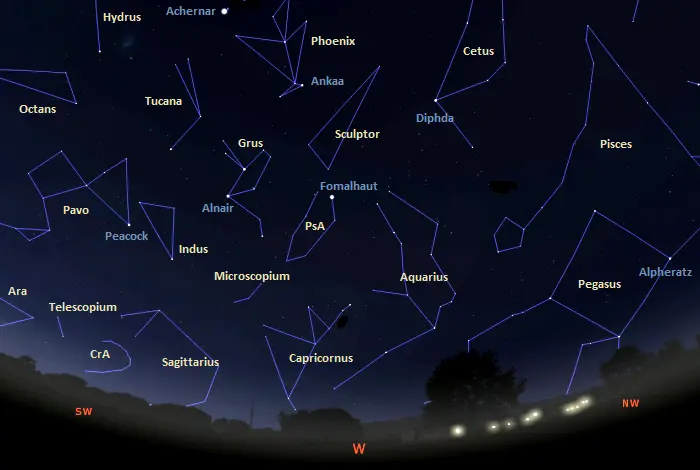
Western sky in the southern hemisphere, image: Stellarium
The faint V of Capricornus appears upside down and can be made out between the bright Fomalhaut and the western horizon on a clear, dark night.
Microscopium (the Microscope), one of the smallest and faintest constellations in the sky, appears above Capricornus. Its brightest star, the yellow giant Gamma Microscopii, shines at magnitude 4.68 and is difficult to see from light-polluted areas.
Fomalhaut, the 18th brightest star in the sky, appears almost directly west. The star shines at magnitude 1.16 from a distance of 25.13 light-years and is the only first-magnitude star in the western sky. It can be found by extending a line from the western side of the Great Square of Pegasus. The rest of its host constellation, Piscis Austrinus (the Southern Fish), is much fainter and harder to see.
Sculptor, another faint southern constellation, appears directly above Fomalhaut. Its brightest star, the hot blue giant Alpha Sculptoris, has an apparent magnitude of 4.30. The constellation is a popular target for amateur astronomers because it hosts the Sculptor Galaxy (NGC 253), one of the brightest galaxies in the sky.
Grus (the Crane) appears left of Fomalhaut. It is one of the four Southern Birds, along with Tucana (the Toucan), Pavo (the Peacock), and Phoenix. The brightest stars of Phoenix, Grus and Pavo – the orange giant Ankaa and the hot blue stars Alnair and Peacock – are among the 58 stars selected for use in celestial navigation. Their host constellations are not particularly bright but can be found using Achernar and Fomalhaut.
Southern sky
Four first-magnitude stars appear low above the southern horizon in the evening. They form two exceptionally bright asterisms: the Southern Pointers and the Southern Cross.
Rigil Kentaurus and Hadar (Alpha and Beta Centauri) are the third and 11th brightest stars in the sky. They mark the forefeet of the Centaur represented by the constellation Centaurus. Together, they are known as the Southern Pointers because they point toward Gacrux, the star at the top of the Southern Cross.
Alpha Centauri is the nearest star system to the Sun. It consists of the brighter Rigil Kentaurus and Toliman (Alpha Centauri A and B) and the faint red dwarf Proxima Centauri (Alpha Centauri C), the nearest individual star to Earth. Proxima lies 4.2465 light-years away and the brighter pair is 4.344 light-years away.
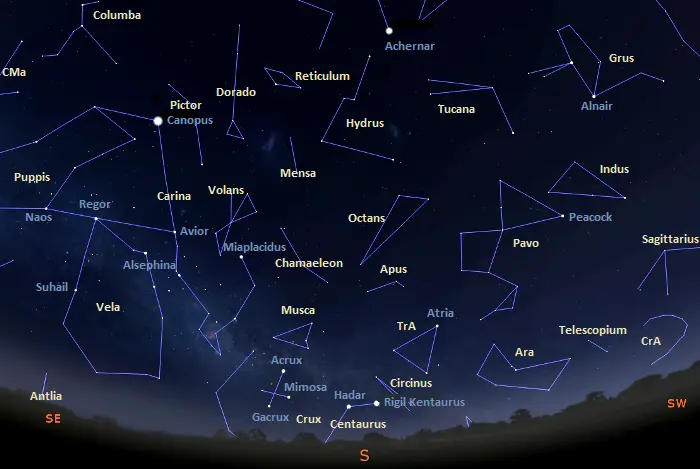
Southern sky in the southern hemisphere, image: Stellarium
The slightly fainter Hadar is much more intrinsically luminous than the components of Alpha Centauri but lies at a greater distance. Located about 361 light-years away, Beta Centauri is a triple star system believed to consist of three hot blue components. Two of the three components have more than 10 times the mass of the Sun.
The Southern Cross is one of the most recognizable asterisms in the southern sky. Largely invisible to observers in the northern hemisphere, the asterism is circumpolar south of the equator. It never falls below the horizon for most southern observers.
The Southern Cross consists of the five brightest stars of the constellation Crux: Acrux (Alpha Crucis), Mimosa (Beta Crucis), Gacrux (Gamma Crucis), Imai (Delta Crucis), and Ginan (Epsilon Crucis). The first-magnitude Acrux and Mimosa are the 13th and 20th brightest stars in the sky, and the second-magnitude Gacrux is the 25th brightest star.
A line extended from Gacrux through Acrux points in the general direction of the south celestial pole, which lies in the faint constellation Octans (the Octant), roughly halfway between Hadar in Centaurus and Achernar in Eridanus.
Sigma Octantis (Polaris Australis) marks the position of the south celestial pole. With an apparent magnitude of 5.45, the star is barely visible even in the best of conditions. For this reason, the bright stars of Crux, Centaurus and Eridanus are used as guides to true south instead.
The Southern Cross and the Southern Pointers can also be used to find the small constellations Musca (the Fly), Circinus (the Compass), and Triangulum Australe (the Southern Triangle). The three constellations are fainter than Centaurus and Crux, but their distinctive patterns make them easy to identify on a clear night.
Apus (the Bird-of-Paradise) lies above Triangulum Australe and Chamaeleon above Musca. Both constellations are very faint. Their brightest stars have apparent magnitudes of about 4.00.
The orange bright giant Atria (Alpha Trianguli Australis), the lucida of Triangulum Australe, is one of the bright stars selected for use in celestial navigation. The star shines at magnitude 1.91 and is part of the triangle that gives the constellation its name.